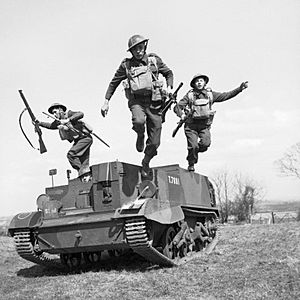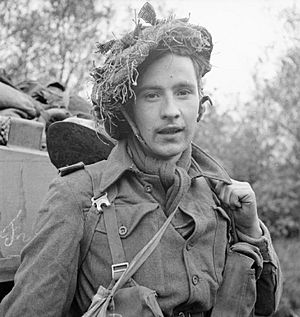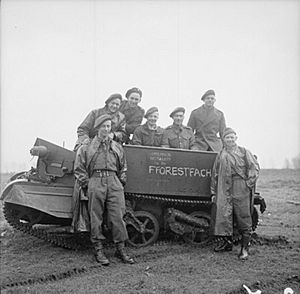Monmouthshire Regiment facts for kids
Quick facts for kids Monmouthshire Regiment |
|
|---|---|

Cap badge
|
|
| Active | 1908–1967 |
| Country | |
| Branch | |
| Type | Infantry |
| Size | 1–10 battalions |
| Engagements | Second Boer War World War I World War II |
The Monmouthshire Regiment was a special group of soldiers in the British Army. They were part of the Territorial Army, which meant they were volunteers who trained in their spare time but could be called up for war. This regiment started with volunteer groups in Monmouthshire in 1859. They bravely fought in the Second Anglo-Boer War, World War I, and World War II. The regiment kept its own name until 1967.
Contents
How the Regiment Started
In 1859, many volunteer groups called "rifle volunteers" were formed across Great Britain. People were worried that France might invade, so they wanted to be ready to defend their country. The first group in Monmouthshire started on September 9, 1859.
By 1880, these smaller groups in Monmouthshire joined together. They formed three larger units, known as the 1st, 2nd, and 3rd Monmouthshire Rifle Volunteer Corps. A year later, these volunteer groups became part of a bigger, regular army regiment called the South Wales Borderers.
Even though these volunteer groups didn't fight as whole units, some of their members volunteered to serve in the Second Boer War in South Africa. They joined the 2nd Battalion of the South Wales Borderers. For their bravery, they earned a special award called a "battle honour" for "South Africa 1900-02".
Creating the Monmouthshire Regiment
In 1908, the British Army changed how its reserve forces were organized. The old volunteer groups were replaced by a new group called the Territorial Force.
On April 1, 1908, the three Monmouthshire volunteer battalions became part of this new force. They were renamed and formed their own regiment, called the Monmouthshire Regiment.
The battalions were:
- 1st (Rifle) Battalion: Based in Newport.
- 2nd Battalion: Based in Pontypool.
- 3rd Battalion: Based in Abergavenny.
These battalions, along with another from Herefordshire, formed the Welsh Border Brigade. This brigade was part of the 53rd (Welsh) Infantry Division.
The First World War
When World War I began in August 1914, the Territorial Force was called into action. The Monmouthshire Regiment formed many battalions. Most of them fought on the Western Front in Europe.
- 1/1st (Rifle) Battalion: This battalion went to France in February 1915. They fought bravely in the Second Battle of Ypres and had many soldiers injured. Because of their losses, they temporarily joined with other Monmouthshire battalions. Later, they became a "pioneer battalion" for the 46th (North Midland) Division. Pioneer battalions helped build trenches and other important structures. They stayed with this division until the war ended in November 1918.
- 1/2nd Battalion: This group also went to France in November 1914. They spent the winter fighting in trenches near Armentières. They also took part in the Second Battle of Ypres in 1915, fighting alongside the other Monmouthshire battalions. After suffering heavy losses, they too temporarily combined with other units. Later, they became a pioneer battalion for the 29th Division. They continued this role until the war ended.
- 1/3rd Battalion: This battalion arrived in France in February 1915. They fought with the other Monmouthshire battalions at the Second Battle of Ypres. Like the others, they faced many losses and temporarily joined forces. Later, they became a pioneer battalion for the 49th (West Riding) Division. However, it became hard to find new soldiers for this battalion because many men in Monmouthshire worked in important industries like coal mining. So, this battalion was disbanded in August 1916.
Other battalions, like the 2/1st, 2/2nd, 2/3rd, 3/1st, 3/2nd, and 3/3rd Battalions, were formed as "second-line" or "third-line" units. They mostly stayed in the United Kingdom, helping with home defense and training new soldiers.
Between the World Wars
After World War I ended, all the Territorial Force units were temporarily stopped. But in 1920, new soldiers started joining, and the force was renamed the Territorial Army.
The three Monmouthshire battalions were restarted in February 1920:
- 1st (Rifle) Battalion in Newport
- 2nd Battalion in Pontypool
- 3rd Battalion in Abergavenny
In 1922, the 3rd Battalion joined with another group to become the 3rd (Brecknockshire and Monmouthshire) Battalion, The Monmouthshire Regiment.
As the threat of another war grew in Europe, the Territorial Army changed again. In 1938, the 1st Battalion became a "searchlight regiment." This meant they used powerful lights to find enemy aircraft at night. They were called the 1st (Rifle) Battalion, The Monmouthshire Regiment (68th Searchlight Regiment).
By June 1939, just before World War II, the regiment had four battalions:
- 1st (Rifle) Battalion (68th Searchlight Regiment)
- 2nd Battalion
- 3rd Battalion
- 4th Battalion (a new group formed from the 2nd Battalion)
The Second World War
1st (Rifle) Battalion
This battalion, which had become a searchlight regiment, officially joined the Royal Artillery in August 1940. They helped defend against air attacks throughout the war. In November 1944, they changed back to an infantry unit and helped with supplies and communications for the army in North West Europe.
2nd Battalion
The 2nd Battalion was called up for war in September 1939. After a lot of training, they landed in Normandy, France, in June 1944, a few weeks after D-Day. They fought in the Battle for Caen and took part in Operation Epsom, spending two weeks in trenches.
They then fought in the Battle of the Falaise Gap in August 1944. Here, they had many soldiers injured, and two of their companies had to combine. Later, they helped free the town of Merville and crossed into the Netherlands. In October, they helped attack the city of 's-Hertogenbosch.
In December 1944, they helped stop the German attack in the Ardennes forest, known as the Battle of the Bulge. In January 1945, they moved to the Netherlands for more training. They entered Germany in February, fighting for a month and suffering 300 casualties before getting a rest.
The battalion kept moving across Germany. Their last big fight was crossing the River Aller in April 1945. They were in Hamburg when Germany surrendered. After the war, they went to Italy and were disbanded in September 1946.
3rd Battalion
The 3rd Battalion was also called up in September 1939. They trained in Northern Ireland and England. In May 1942, they joined the 11th Armoured Division and trained for two more years. On June 14, 1944, they landed in Normandy, just eight days after D-Day.
They spent weeks trying to break out of the area around Caen. In August, they were almost surrounded by enemy forces and lost many soldiers. They had to temporarily combine with another battalion. During this fighting, a brave soldier from the other battalion, Corporal Sidney Bates, was awarded the Victoria Cross, the highest award for bravery.
After getting more soldiers, the battalion chased the retreating German forces. They passed through Belgium and helped free Antwerp in September 1944. They then moved into the Netherlands to protect airborne troops during Operation Market Garden. Their commanding officer was killed in September 1944. In November 1944, they fought in the Battle of Broekhuizen.
In February 1945, they broke through the Schlieffen line. They then crossed the Rhine River into Germany in April 1945. They faced very strong resistance. Another brave soldier, Corporal Edward Thomas Chapman, was awarded the Victoria Cross for his actions during this fight.
The battalion suffered many casualties (40 killed, 80 wounded) and did not take part in any more fighting. They were disbanded in January 1946. Throughout the war, this battalion had 1,156 casualties, including 242 soldiers who died.
4th Battalion
The 4th Battalion was formed in June 1939. They were called up in August 1939. This battalion stayed in the United Kingdom during the war. They performed guard duties and helped train new soldiers. In December 1942, they were renamed the 1st Battalion, South Wales Borderers.
After the War: Changes and End
After World War II, many army units were stopped. The Territorial Army was restarted in April 1947, but with fewer units. The Monmouthshire Regiment was reduced to just one group: the 2nd Battalion, based in Pontypool.
The former 1st (Rifle) Battalion did not return to the regiment. It stayed in the Anti-Aircraft Command, using searchlights and anti-aircraft guns. They even had women soldiers join them. They kept wearing their special cap badge.
The 3rd Battalion also changed. It became an anti-aircraft regiment in the Royal Artillery. It later combined with another unit and stopped existing as a separate group.
In 1967, the last remaining Monmouthshire battalion was disbanded. However, a new unit called the Welsh Volunteers carried on the history of all Welsh volunteer infantry battalions. Today, their history is continued by the 3rd Battalion, the Royal Welsh.
Battle Honours
The regiment earned many special "battle honours" for their bravery in different battles. These honours were displayed on their flags and uniforms.
- South Africa 1900-02
- Ypres 1915 '17 '18
- Gravenstafel
- St. Julien
- Frezenberg
- Bellewaarde
- Somme 1916
- Albert 1916
- Arras 1917
- Scarpe 1917
- Pilckem
- Langemarck 1917
- Poelcappelle
- Cambrai 1917 '18
- Lys
- Messines 1918
- Hindenburg Line
- St. Quentin Canal
- Beaurevoir
- Courtrai
- Sambre
- France and Flanders 1914-18
- Aden
- Odon
- Bourguébus Ridge
- Mont Pincon
- Souleuvre
- Le Perier Ridge
- Falaise
- Antwerp
- Nederrijn
- Lower Maas
- Venlo Pocket
- Ourthe
- Rhineland
- Reichswald
- Weeze
- Hochwald
- Rhine
- Ibbenburen
- Aller
- North-West Europe 1944-45




